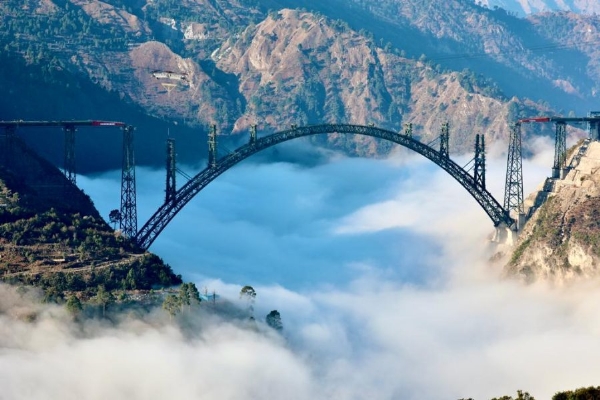World’s highest Chenab Railway bridge in J&K nears completion; to open soon
The bridge is being constructed by Mumbai-based infrastructure major Afcons, keeping safety, quality and productivity as their main driving parameters.
Total Views |
Srinagar, August 10: India will soon be witnessing another milestone at the world’s highest railway bridge, in Jammu and Kashmir, when the overarch deck launching of Chenab Railway Bridge gets completed with a golden joint, this month.

30,350 MT of steel has been used in the 1315 m long Chenab Railway Bridge construction. 10,620 MT of steel has been consumed in the construction of the gigantic arch, and 14,504 MT of steel has gone into the construction of the bridge deck.
“For the first time in Indian Railways, incremental launching was done on transition curve and a longitudinal gradient, both occurring at same location, for the deck launching of the viaduct portion of the Chenab Bridge. Typically, bridges have been constructed incrementally on a straight or a curved platform with a uniform radius. Executing launching activities in inclement weather and stormy wind conditions was extremely challenging,” Giridhar said.
Giridhar said, “We received tremendous support for any technical issue, approval for drawings, method statements, and most importantly, both NR and KRCL played an important role in generating local employment. KRCL constructed all the access roads to the project site. These roads have provided connectivity to far-flung villages in the region.”
“Considering the treacherous hilly terrain, temporary launching platform with segment lifting capacity of 120 MT and for a height of about 39 m was designed. We developed and implemented several innovative methods to overcome the challenges of the hilly terrain for successfully executing our launching activities,” Giridhar said.
For the first time in India, a fully equipped NABL laboratory was set up to ensure quality was being monitored at every stage of the project. “The Northern Railways supported us in setting up the NABL lab at site for conducting weld sample tests. This saved a lot of time,” he added.
With KRCL’s support, Afcons could carry out mock-up of all main bridge components before executing the original work which gave confidence to the engineers. Once completed, the Chenab Railway Bridge will be 35m higher than the Eiffel Tower.

In the Chenab Bridge, 93 deck segments (each weighing 85T) have been simultaneously launched from both ends of valley over the steel arch and 5 are in progress. Both ends will meet to complete the bridge overarch deck and segments will be joined with High Strength Friction Grip (HSFG) bolts to mark the golden joint.
“The overarch deck completion, 359 m above the Chenab riverbed, will be an extraordinary achievement. I have my highest respects for every engineer and worker who have contributed to this engineering achievement. This golden joint will usher in a golden moment in the history of Indian Railways and will become a golden chapter in the history of Jammu and Kashmir. Construction engineering was completely done by Indian engineers which makes the Chenab Railway Bridge a symbol of Atmanirbhar Bharat,” said Giridhar Rajagopalan, Deputy Managing Director of Afcons.
30,350 MT of steel has been used in the 1315 m long Chenab Railway Bridge construction. 10,620 MT of steel has been consumed in the construction of the gigantic arch, and 14,504 MT of steel has gone into the construction of the bridge deck.
The bridge is near Kauri village in Reasi district of Jammu and Kashmir. The bridge is being constructed by Mumbai-based infrastructure major Afcons, keeping safety, quality and productivity as their main driving parameters.
Giridhar said, “We received tremendous support for any technical issue, approval for drawings, method statements, and most importantly, both NR and KRCL played an important role in generating local employment. KRCL constructed all the access roads to the project site. These roads have provided connectivity to far-flung villages in the region.”
“The Northern Railways allowed us to use the Phased Array Ultrasonic Testing Machine for inspection of welds. This was done for the first time in India,” he added.
For the first time in India, a fully equipped NABL laboratory was set up to ensure quality was being monitored at every stage of the project. “The Northern Railways supported us in setting up the NABL lab at site for conducting weld sample tests. This saved a lot of time,” he added.
With KRCL’s support, Afcons could carry out mock-up of all main bridge components before executing the original work which gave confidence to the engineers. Once completed, the Chenab Railway Bridge will be 35m higher than the Eiffel Tower.